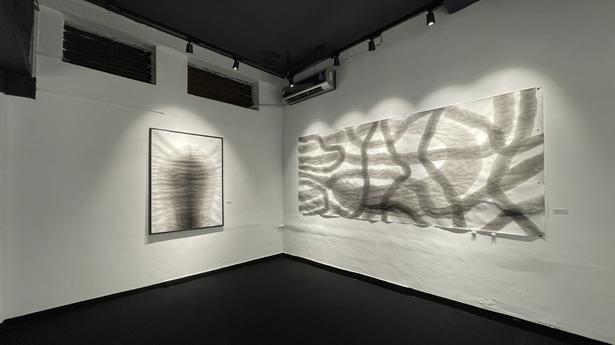
Artist Jineshbabu K’s experiments in Indian ink on display at an exhibition in Thiruvananthapuram
The Hindu
‘Intractable labyrinth of infinite layers’ showcases Jineshbabu K’s works in water colour and Indian ink
Jinesbabu K’s paintings look compact and minimalistic. But as the title of the exhibition suggests — ‘Intractable labyrinth of infinite layers’ — there are many layers to his works in water colour and Indian ink, which are on display at Amuseum in the city.
An image that seamlessly runs through his paintings is thazha or screw pine, which used to grow in plenty in his native place, Thazhava, a village in Karunagappally taluk of Kollam district. The region was once famous for products made of screw pine, especially the thazhappaaya or screw pine mats. “It is now a dying cottage industry and I have been witness to the golden phase. Also, since there used to be screw pines everywhere, people used to make up stories about them, mostly horror tales about yakshis and other creatures of the nether world. Those spooky tales that were part of my growing up years influenced the works I did in college,” says Jinesh, a graduate of the College of Fine Arts, Thiruvananthapuram. He has showcased reproductions of some of these works in oil and acrylic, at the exhibition.
As years went by, thazha continued to be a motif, that too in a more profound way, says Jinesh, adding that he could associate “a mystic feel” to the concept.
It was at Viswa Bharati University, Santiniketan, that he picked up an interest in Indian ink; that brought a transition in his technique and approach. “I began exploring the possibilities of using it alone and blending it with watercolour. Inadvertently, I discovered that layers can be created using this ink because it is waterproof and transparent,” he says.
Meanwhile, pine leaves continued to be a recurring image — the long leaves that arch outward from the centre are painted in layers, with the colour tone progressing from light to dark. “It has become an organic process having experimented with this for quite some time. Now I work on multiple paintings at a time,” he says.
At the exhibition, the artist has kept a collection of paintings to highlight the transparent nature of Indian ink.
Jinesh adds that once he went deep into it, he could find a connection between the leaves and the human body. That explains the backbone-like structure that runs through the painting. He picked up new techniques along the way. “For instance, if you apply the ink on the canvas and once it sets, you can take out that colour out by wetting the surface. The colour bleeds thereby creating new shapes. Some say this technique gives it a cloud-like effect,” he explains.











